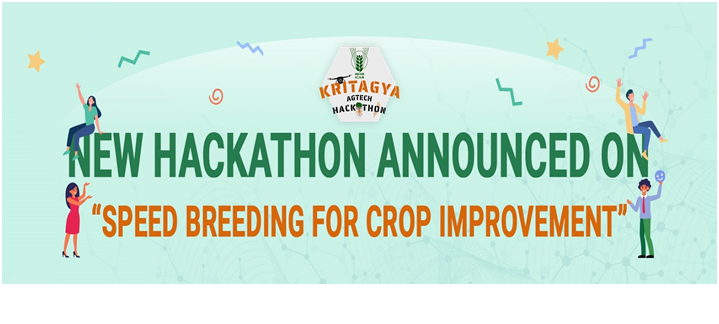KRITAGYA 3.0 (GS Paper 2, Issues related to Development of Social Sectors)

Why in news?
- Indian Council of Agricultural Research with its National Agricultural Higher Education Project and Crop Science Division is organizing Hackathon 3.0 ‘’KRITAGYA” on promoting ‘speed breeding for crop improvement’.
Details:
- Through National Education Policy-2020, this program will provide an opportunity to students/faculties/entrepreneurs/innovators and others to showcase innovative approaches and technology solutions to promote innovation for crop improvement.
- It will also encourage greater adoption of technology enabled solutions in the country.
KRITAGYA:
- KRI for Krishi meaning Agriculture, TA for Taknik meaning Technology and GYA for Gyan meaning Knowledge.
- In this competition, students, faculty and innovators/entrepreneurs from any university/technical institute across the country can apply and participate in the program as a group.
- The participating group shall consist of maximum 4 participants, with not more than one faculty and / or more than one innovator or entrepreneur.
- Participating students can collaborate with local start-ups, students from technology institutes and can win up-to INR 5 Lakhs.
Background:
- During 2020-21 and 2021-22 NAHEP in association with Agricultural Engineering and Animal Science Divisions of ICAR organized Hackathon 1.0 and 2.0 to promote the innovation in Farm Mechanization and in Animal Science, respectively.
- This event is also extending the support to winners for further development in their concept propositions, its scalability and future plan in collaboration with Agri Business Incubators, MSMEs and other investors through support of ICAR.
National Agricultural Higher Education Project:
- ICAR commenced National Agricultural Higher Education Project with the assistance of World Bank (WB) in November 2017.
- The overall objective of NAHEP is to support participating Agricultural Universities (AUs) and ICAR in providing more relevant and higher quality education to the students.
Govt clears 23 strategic projects under National Technical Textiles Mission
(GS Paper 3, Economy)
Why in news?
- Recently, the Centre has cleared 23 strategic research projects of around Rs 60 crore in the areas of specialty fibres, sustainable textiles, geotextiles, mobiltech and sports textiles under its flagship programmeNational Technical Textiles Mission.

Focus Areas:
- Identification of the area of research in technical textiles with industry interaction and promotional activities like conferences, exhibition, and buyer-seller meet to promote the use of Technical Textile in the country and to increase the exports to be the key focus areas,.
Key Highlights:
- Among these 23 research projects, 12 projects of SpecialityFibres having application areas in agriculture, smart textiles, healthcare, strategic application and protective gears were cleared.
- Four projects from sustainable textiles having application area in agriculture and healthcare sector were cleared.
- Five projects from geotextile, 1 from mobiltech and 1 from sportech were cleared.
About National Technical Textiles Mission:
- The Government approved the proposal for creation of National Technical Textiles Mission for a period of 4 years (2020-21 to 2023-24) with an outlay of Rs.1480 crores in September 2020.
- The distribution of funds is (i) For Research Innovation & Development – Rs. 1000 crores, (ii) For Promotion and Market Development- Rs.50 crore, (iii) For Education, Training and Skilling- Rs. 400 crore, and (iv) For Export Promotion – Rs.10 crores and balance Rs.20 crores for administrative expenses.
Indian and US firms unite to build satellite with both Synthetic Aperture Radar and optical sensors
(GS Paper 3, Science and Tech)
Why in news?
- Three Indian aerospace firms (GalaxEye, Ananth Technologies and XDLINX Labs) have come together to unite with an American software platform provider (Antaris) to create an earth observation satellite that will have both optical sensors and a Synthetic Aperture Radar.

Geospatial imagery:
- Announcing the signing of a Memorandum of Understanding (MoU), the companies said that they were working towards creating the world's first geospatial imaging satellite featuring both SAR and Optical sensors.
- Geospatial imagery refers to the broad spectrum of work that aims to measure and visually analyze the earth from up above and understand various changes, natural processes, environmental phenomena etc.
Key Highlights:
- Under the terms of the agreement, Antaris will provide the SaaS technology platform required to design, simulate, build and manage the earth observation satellite from GalaxEye and its onboard Drishti sensor.
- Ananth Technologies will provide AIT (Assembly, Integration and Test) services and manufacturing capabilities.
- XDLINX Labs, will be responsible for the design of the spacecraft bus and supply chain integration services.
Scope:
- Typically, satellite constellation operators have deployed specialized satellites to capture specific types of data. Each image or data point is captured at a unique time from a unique location, making it difficult to correlate data from separate satellites.
- In this setup, the satellite would be able to function like a camera and click colour images of the earth, amid favourable weather conditions (during the day, clear skies etc.) and also click detailed black-and-white images using a Synthetic Aperture Radar, which can provide imaging during day& night and during all weather conditions.
- This satellite is expected to be launched by end of 2023.
Way Forward:
- The resulting datasets will have tremendous value for environmental, insurance and defence applications.




